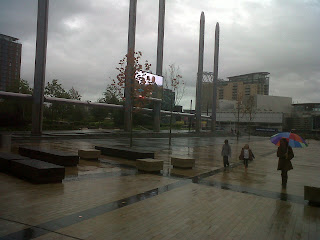Despite the title "No-tie Zone," they came to the
NLA conference on Tech City in ties. They were mostly estate agents after all.
From an anthropological perspective, it was interesting to see how the property industry is engaging with the Shoreditch community whose growing tech/ digital cluster is attacting so much attention. Creative tech-types might not naturally gel with the men-in-suits, but give them a bike rack, exposed brickwork and a flexible lease, and the two groups might find common ground.
Elizabeth Varley, CEO of the successful coworking space TechHub - made famous after PM David Cameron chose to launch the government Tech City policy from here on its first birthday - spoke of the importance of flexible contracts in the start-up world where the office needs of fast-growing start-ups are difficult to predict. For TechHub, she said she managed to negotiate a good deal on rent with Derwent, who own the building. Incidentally I chatted to someone involved in the deal who said the ground floor, where TechHub is located, had proved difficult to lease and had been empty for some time before TechHub moved in. One priority for Andrew Sissons, Head of Regeneration Delivery at Hackney, is the provision of affordable workspaces such as TechHub: one way of managing the inflation in property prices caused as the cluster attracts attention.
Andrew Bridges, Managing Director of Stirling Ackroyd, predicted the ownership of the area will change. The tech and creative types may shift to Haggerston and Dalston, where costs are 30 perecnt cheaper. The challenge for Stirling Ackroyd is how to bring larger sites on board due to fragemented ownership: an argument that suits the government's rationale for allying the Olympic Park - where large spaces are plentiful - to the Old Street cluster.
Celine Thompson, Head of Leasing at Derwent London, spoke of the high ceilings and flexible, inspirational spaces her clients are looking for. They are calling this a White Collar Factory (terrible name) with 5 pinciples: 1. Tall ceiling; 2. Smart servicing; 3. Simple passive façade; 4. Deep plan and 5. Concerete structure. Basically it means flexible floor plate and being able to open the window.
Hammerson is the largest landowner in Tech City area. Andrew Hilston, Assistant Director of Development, gave a very interesting presentation of the Goodyard site, now awaiting planning permission. Plans are inspired by New York's Highline and foresee an urban park on top of railway arches. In the meantime, there is room for temporary uses such as the pop-up retail centre BoxPark (a joint venture with Hammerson (retail, office expertise) and Ballymore (resi)).
For me, perhaps the most interesting presentation came from Peter Bennett of the City of London Corporation. I had not appreciated the City's role in spotting and nurturing this particular cluster of activity, but now I know the corporation is not entirely focussed on finance. Ten years ago, the City invested in property that it thought might help grow the cluster, mainly just outside City boundary (Bonhill St, now home to Google Campus, Smithfield Innovation Warehouse, among others).
Finally, Steve Edge, who bills himself as a Prophet, Madman, Wanderer, spoke of the colour that first brough artists to the area. “My big problem is when lawyers and accountants come in and then it will be time for us the artists to move out,” he said.



























